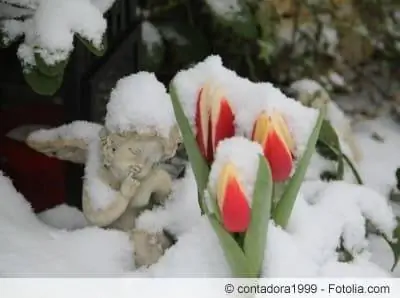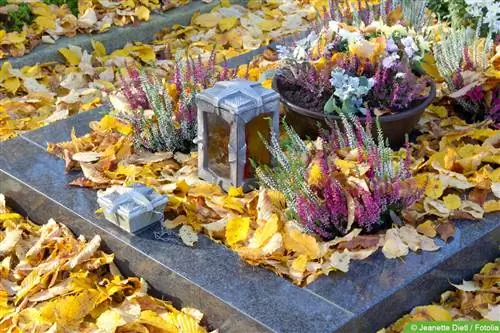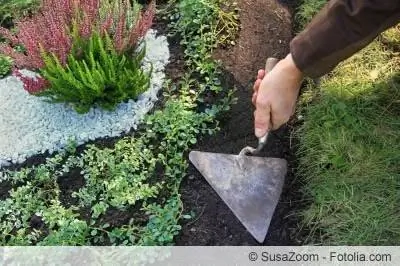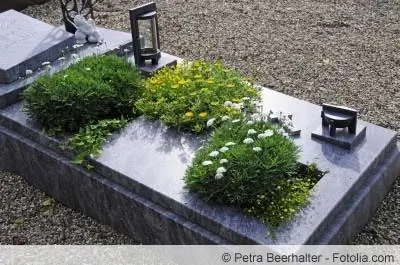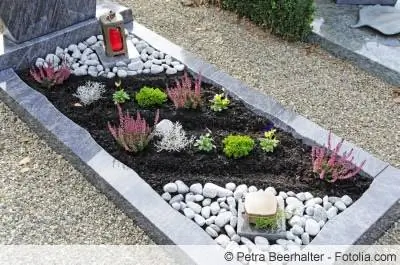- Author admin [email protected].
- Public 2023-12-17 03:39.
- Last modified 2025-06-01 06:48.
In any season, the life of nature can create a calming, contemplative and dignified atmosphere on graves. This is also the case in winter if appropriate planting is selected. There are many ways to combine the decorative plants with grave design elements such as grave lights, small statues and other elements to create a harmonious overall picture. However, when planting graves in winter, it is important that the plants are easy to care for and robust and still bring color to the otherwise monotonous season.
Basics for winter grave design
Soil preparation is a must
Even hardy plants like airy, fertile and water-permeable soil. Therefore, loosen the soil well after removing the summer and autumn plants. Add fresh potting soil and, if necessary, some peat moss, depending on the plants being used. Also remove any fallen leaves when planting new plants or dig them in a little. If there are still flowering plants or a frame planting on the grave, for example with evergreen ground cover, it is best to remove the leaves very carefully so as not to damage the plants.
Tip:
For a very aesthetic grave look, specialist retailers offer special grave soil in deep black. In this nutrient-rich soil, flowering plants or foliage plants come into their own in winter.
Evergreen ground cover as a basis
Evergreen ground covers are very easy to care for and robust. They can remain green even in dry or shady places and therefore fit very well into a grave design. Evergreen means that the leaves of the plants remain green even in winter. This creates a welcome setting for winter flowering plants. They also prevent weed growth. Evergreen ground cover plants can be planted in late autumn, just before the onset of winter:
- Ysander (Pachysandra terminalis)
- Large-leaved Irish ivy (Hedera helix hibernica)
- White Creeping Spindle 'Emerald Gaiety' ((Euonymus 'Emerald Gaiety')
- Cotoneaster 'Variegatus' (Cotoneaster horizontalis 'Variegatus')
- Brown-red prickly nut 'Copper Carpet' (Acaena microphylla 'Copper Carpet')
Tip:
If you would rather just plant ground cover on the grave, you don't necessarily have to forego a variety of flowers and blossoms. Hardy plants can also be placed very well in planting bowls between the ground cover.
Hardy flowering plants
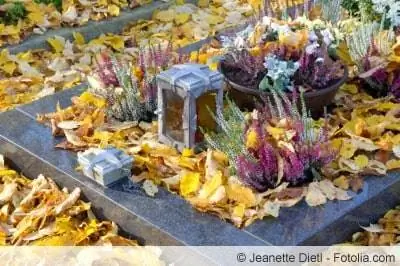
To make a grave attractive and pretty even in winter, use hardy plants that bloom in winter or have colorful leaves:
Winter heather 'Rosalie®' (Erica carnea 'Rosalie®')
- also called snow heather
- Flower color pure pink
- Flowering period December to March
- low and compact growth
- can be beautifully planted to form a flowering carpet
Winter heath 'Blizzard' (Erica carnea 'Blizzard')
- beautiful white flowers
- otherwise like winter heather 'Rosalie®'
Hardy bud heather ‘Sandy’ - Garden Girls® (Calluna vulgaris ‘Sandy’)
- also called broom heather
- bright golden yellow leaves
- Flowering period September to November
- white flower buds don't open
- goes very well with winter heather ‘Rosalie®’
Red Christmas rose 'Red Lady' (Helleborus orientalis)
- large, green, stable, slightly shiny leaves
- Flowering period February to May
- purple flower
True snow Christmas rose (Helleborus niger)
- white, cup-shaped flowers
- Flowering period December to March
- otherwise like red Christmas rose 'Red Lady'
Bergenia 'Purpurea' (Bergenia cordifolia 'Purpurea')
- dark green-brownish, leathery, broad to rounded leaves
- brown-reddish leaf color in autumn to winter
- pink to purple flowers in umbels
Blue fescue (Festuca glauca)
- grows hemispherical to cushion-like
- yellow-brown flowers in panicles
- blue-green stems even in winter
Shrubs and conifers for the background
Conifers and shrubs, which look attractive all year round, including in winter, are also often planted on graves. Some ornamental shrubs delight us with red berries in winter. However, you should make sure that the shrubs and conifers, which are usually taller, are in the background and do not obscure the lower, flowering plants. Conifers or shrubs are often planted to the right and left of the gravestone. For example, the following are suitable:
- Winter-blooming alpine rose (Rhododendron praecox)
- Japanese dwarf yew selection 'Gustav Schlüter' (Taxus cuspidata 'Heckenstar')
- Lavender heather/shadow bell 'Bonfire' (Pieris japonica 'Bonfire')
- Holly - Ilex 'Hedge Fairy' (Ilex meservae 'Hedge Fairy')
- Muscle cypress 'Nana Gracilis' (Chamaecyparis obtusa 'Nana Gracillis')
- Blue dwarf juniper (Juniperus squamata 'Blue Star')
- Common boxwood (Buxus sempervirens)
Various design options and ideas
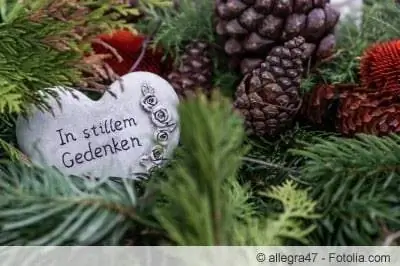
The graves can be laid out in very different ways, depending on the size and taste of the family and the deceased. The favorite flowers of the deceased are often planted on the grave or placed on the grave as a bouquet.
Graves with evergreen borders
An urn grave usually has very little space. A border with evergreen boxwood or ysander, with alternating planting in the middle, is best suited here. Alternating planting can look different:
- Two triangles: A beautiful picture results from a geometric division of the square surrounded by the boxwood into two differently planted triangles. For example, one triangle is planted with pink winter heather and one triangle with white winter heather. If you like, you can also create a diagonal between the two triangles with boxwood.
- Square with diagonal: Only one type of plant is used here, for example Bergenia. A planting of golden yellow heather fits as a diagonal.
- Heart: If the alternate planting is arranged in a heart shape, the remaining area can be completely planted with boxwood to create a green carpet for the colored heart. The heart structure can be planted with a single plant species such as heather, calluna or Christmas rose or mixed.
- modern geometric structures: On modern graves there are often complicated planted geometric structures, such as in the form of a yin-yang symbol or other imaginative structures, the surfaces of which are planted in different colors are. For example, with hardy pansies in different colors.
- Butterfly: For example, a butterfly structure can be planted on a child's grave. Each wing can feature a different type of plant. The border is made with boxwood or another evergreen plant.
Graves with a border of flowering plants
The design can of course also be done the other way round. Outside a frame with flowers and inside the frame a green area that has a certain structure. Wreaths, arrangements or plant bowls can be placed on the green surface.
- Heart as a frame: A heart made of winter heather or hardy pansies, for example, looks wonderful. Depending on your taste, the heart can be planted inside with other plants like a bowl. It should be noted that the external plants have a lower growth height.
- Gravel as a border or as a structural element - White gravel can also decorate a grave in conjunction with plants, black grave soil, plant bowls and arrangements, for example on a single grave.
- Cross: Either the gravel is placed as a cross in the middle of the grave or it is used as a border while plants form the cross in the middle. Simple graves are only planted with evergreen plants and receive alternating plant bowls that decorate the grave area to the right and left of the cross.
Other design elements
- Bouquets of roses and other flower bouquets: If there is not such severe frost in winter, you can also combine bouquets of flowers for winter planting or plant bowls. For example, roses are very suitable for this and last for several weeks in cool temperatures.
- Place patterns: From branches of noble fir, blue spruce, false cypress or juniper, you can accurately insert various patterns into the ground that harmonize with the winter planting. For example, this grave decoration is very suitable if you have not planted an evergreen base. Usually several plants of one variety are planted in the middle of the pinned branches, creating a heart shape.
- Candles and figures - Small figures are usually decorated on the branches or between the planted winter bloomers, which create a beautiful, contemplative design with candles and grave lights.
Tip:
There are so many ways to design a grave. It's best to draw up beforehand how it should be designed and which structures need to be provided with which plants.
Conclusion
Shrubs, conifers, evergreen ground cover and hardy flowering plants create a contemplative yet colorful grave planting. The plants can still be planted out into December as long as the ground is not frozen. The middle of the grave is usually sufficient for a changing planting, while shrubs and conifers in the background and the base planting of evergreen plants remain throughout. This means that the grave is beautiful all year round and also receives an expression of appreciation and remembrance in the winter.

